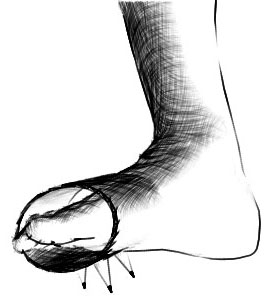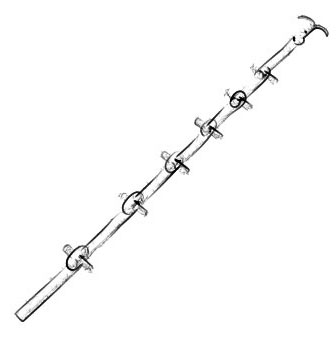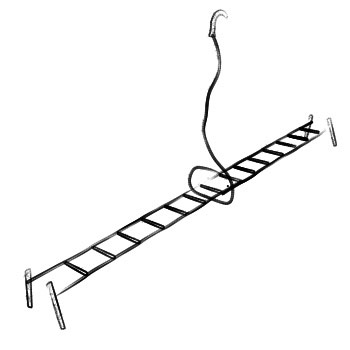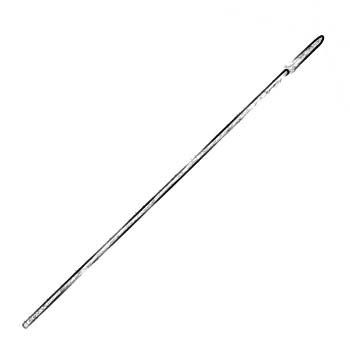Climbing Tools
Ashikō

The counterpart to the shukō (hand claw) is the ashi kō. A device similar to that on the hand was placed under the Ninja’s foot. Getting kicked made worse injuries that way, and climbing was far easier.
Ippon sugi nobori

A way to climb up a cedar. With this tool, the Ninja could climb trees. The iron prongs were used to pull the rope a little bit higher. In principle, it works exactly like the tool used today to climb telegraph poles.
Kagi nawa

This grappling anchor was attached to a rope and with its four sacks it easily got caught in an obstacle on a tree or building.
Kagi yari

Togakure-Ryū Ninja often used the hooked spear. You could get into trees, over walls, or onto ships. It was also possible to get from tree to tree in this way. Hidden on a high post, a victim could be caught with the hook and pulled up. It was also suitable for fishing, breaking down doors, or transporting luggage.
Kasha

This pulley was used to move quickly along horizontally stretched ropes.
Kuda bashigo

Pipe ladder. This ladder could be folded very small.
Kumade

Bear Claw. This rake could be used for climbing or as a fearsome weapon.
Kumo bashigo

Cloud ladder. A rope with cross braces.
Kumo bashigo

Spider ladder. This ladder was used to climb trees.
Musubi bashigo

Loop ladder. This rope had loops at a certain distance into which one could put one’s feet. That made climbing easier.
Musubi nawa
A horsehair rope. Ropes were often made of hair, including women’s hair because these were very tear-resistant.
Ninja tō

The short sword was an important tool in Ninja equipment. It wasn’t pretty or valuable like the tachi or katana of the Samurai – it was useful. The blade was much shorter than that of the katana or the tachi. So the Ninja could move better with it and use it in close combat. The blade was sometimes straight, but sometimes it was just a shortened katana. The tsuba (hand guard) was not decorated with beautiful ornaments but mostly larger and made of simple steel, often angular. So you could use it as a climbing aid. The sword was carried at the side and only rarely (e.g. when climbing) over the back or stomach. Poisons, medicines, or chemicals were often hidden in the handle. The saya (scabbard) could be used as a blowgun or breathing tube.
Shukō

A terrible weapon is the shukō. A pointed iron prong was attached to a kind of leather arm ring, whereby the Ninja turned his hand into a tiger claw. The spikes could inflict terrible wounds on the attacker’s face. With this weapon, Ninja could also take swords, i.e. stop the sword strike. At the same time, the Ninja could climb up walls or trees better. The counterpart for the feet was called ashi kō.
Taka bashigo

High Ladder. This ladder was used to get over chasms. Another rope was used to reinforce the center to keep the ladder from sagging.
Tobi bashigo

Jumping Ladder. This ladder had hooks at the ends, making it easier to throw.
Toki
Climbing accessories.
Tsuri bashigo

Hanging Ladder. To be on the safe side, this ladder could be attached to other hooks on a wall.
Yari

The Japanese spears were designed to stab and were rarely thrown. With its small point, one could easily hit between the plates of the Samurai armor. The tips were mostly two- or three-sided. It was usually 200 to 350 cm long. Oda Nobunaga used yari, some 640 cm long, to protect his teppō soldiers against cavalry.
The Ninja often used the yari to high jump over walls or people.